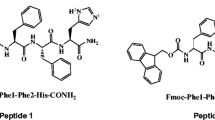Abstract
The molecular mechanism of helix nucleation in peptides and proteins is not yet understood and the question of whether sharp turns in the polypeptide backbone serve as nuclei for protein folding has evoked controversy1,2. A recent study of the conformation of a tetrapeptide containing the stereochemically constrained residue α-aminoisobutyric acid, both in solution and the solid state, yielded a structure consisting of two consecutive β-turns, leading to an incipient 310 helical conformation3,4. This led us to speculate that specific tri- and tetra-peptide sequences may indeed provide a helical twist to the amino-terminal segment of helical regions in proteins and provide a nucleation site for further propagation. The transformation from a 310 helical structure to an α-helix should be facile and requires only small changes in the φ and ψ conformational angles and a rearrangement of the hydrogen bonding pattern5. If such a mechanism is involved then it should be possible to isolate an incipient 310 helical conformation in a tripeptide amide or tetrapeptide sequence, based purely on the driving force derived from short-range interactions. We have synthesised and studied the model peptide pivaloyl-Pro-Pro-Ala-NHMe (compound I) and provide here spectroscopic evidence for a 310 helical conformation in compound I.
Similar content being viewed by others
References
Anfinsen, C. B. & Scheraga, H. A. Adv. Protein Chem. 29, 205–300 (1975).
Wetlaufer, D. B. & Ristow, S. A. Rev. Biochem. 42, 135–158 (1973).
Nagaraj, R., Shamala, N. & Balaram, P. J. Am. Chem. Soc. 101, 16–20 (1979).
Shamala, N., Nagaraj, R. & Balaram, P. Biochem. biophys. Res. Commun. 79, 292–298 (1977).
Ramachandran, G. N., Venkatachalam, C. M. & Krimm, S. Biophys. J. 6, 849–872 (1966).
Grathwohl, C. & Wuthrich, K. Biopolymers 15, 2025–2041 (1976).
Nishihara, H., Nishihara, K., Uefuji, T. & Sakota, N. Bull. Chem. Soc., Japan 48, 553–555 (1975).
Zimmerman, S. S. and Scheraga, H. A. Biopolymers 16, 811–843 (1977).
Wuthrich, K. NMR in Biological Research: Peptides and Proteins (North-Holland, Amsterdam, 1976).
Bystrov, V. F. Prog. NMR Spectroscopy 10, 41–81 (1976).
IUPAC-IUA Commission on Biochemical Nomenclature Biochemistry 9, 3471–3479 (1970).
Dickerson, R. E. & Geis, I. The Structure and Action of Proteins (Harper and Row, New York, 1969).
Chou, P. Y. & Fasman, G. D. J. molec. Biol. 115, 135–175 (1977).
Author information
Authors and Affiliations
Rights and permissions
About this article
Cite this article
Venkatachalapathi, Y., Balaram, P. An incipient 310 helix in Piv-Pro-Pro-Ala-NHMe as a model for peptide folding. Nature 281, 83–84 (1979). https://doi.org/10.1038/281083a0
Received:
Accepted:
Published:
Issue Date:
DOI: https://doi.org/10.1038/281083a0
- Springer Nature Limited
This article is cited by
-
n→π* interactions in proteins
Nature Chemical Biology (2010)





